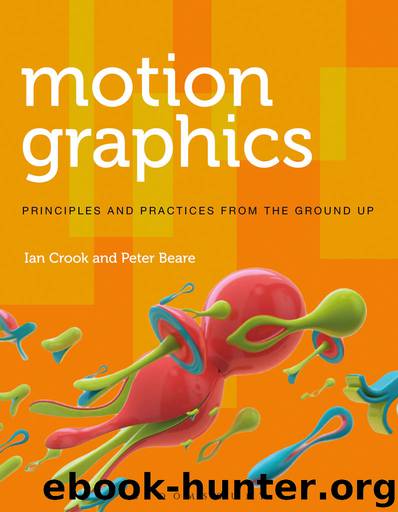Motion Graphics: Principles and Practices from the Ground Up (Required Reading Range) by Ian Crook & Ian Crook & Peter Beare & Peter Beare

Author:Ian Crook & Ian Crook & Peter Beare & Peter Beare [Crook, Ian]
Language: eng
Format: azw3
ISBN: 9781350037724
Publisher: Bloomsbury Publishing
Published: 2017-07-06T04:00:00+00:00
FRAME- RATE
All moving image sequences have duration. The duration of the movie is determined by two things: the number of individual frames and the frame-rate, the number of frames that are displayed during a set interval. We inherit the word footage from the origins of cinema; the duration of a film clip was proportional to the length of the celluloid strip, measured by the US standard foot. These days, it is more conventional to specify the duration of a video clip in minutes and seconds, and to define the frame-rate in frames-per-second (fps).
The duration and the frame-rate together reveal the number of component frames in a movie clip. A one-minute video of 25 frames per second contains 1 (minute) 3 60 (seconds) 3 25 (frames-per-second) equaling 1,500 individual frames of video.
Film and TV frame-rates are standardized. In the UK, the standard frame-rate for TV and video is 25 fps. In the US, the standard is 29.97 fps. Internationally, the standard frame-rate for film is 24 fps, although some filmmakers have been experimenting with high-frame-rate (HFR) cinematography. Peter Jackson’s Hobbit films were produced at double the standard frame-rate: 48 fps.
Animation and motion graphics that are created for other media platforms, such as the web, may have customized frame-rates. An animated GIF or Flash movie on a web page may possess a frame-rate of 1 fps, 10 fps, or 15 fps. With each frame there is new data to be delivered or computed. Too fast a frame-rate can result in too great a processing load on the target device; this can result in a delay while the image sequence is downloaded and reconstituted.
High-speed cameras
Frame-rate also describes the rate at which a camera records a moving image. Slow-motion cinematography involves shooting video footage at very high frame-rates—hundreds or thousands of frames per second—using specialized cameras. When this sequence is replayed at a conventional frame-rate, the effect is that time is dramatically slowed down. An event that lasts half a second in real time would take 10 seconds to watch back if shot at 500 fps.
This is not the same effect as slowing down footage, shot at a standard rate, using post-production techniques. In this case the software has to reinterpolate the frames to “guess” what would come between. The end result will be slower action, but the added frames will not be as sharp or accurate as footage shot on a high-speed camera.
Download
This site does not store any files on its server. We only index and link to content provided by other sites. Please contact the content providers to delete copyright contents if any and email us, we'll remove relevant links or contents immediately.
Shoot Sexy by Ryan Armbrust(17638)
Portrait Mastery in Black & White: Learn the Signature Style of a Legendary Photographer by Tim Kelly(16937)
Adobe Camera Raw For Digital Photographers Only by Rob Sheppard(16886)
Photographically Speaking: A Deeper Look at Creating Stronger Images (Eva Spring's Library) by David duChemin(16603)
Bombshells: Glamour Girls of a Lifetime by Sullivan Steve(13956)
Art Nude Photography Explained: How to Photograph and Understand Great Art Nude Images by Simon Walden(12956)
Perfect Rhythm by Jae(5310)
Pillow Thoughts by Courtney Peppernell(4194)
The Book of Joy by Dalai Lama(3886)
Good by S. Walden(3473)
The Pixar Touch by David A. Price(3349)
A Dictionary of Sociology by Unknown(3000)
Fantastic Beasts: The Crimes of Grindelwald by J. K. Rowling(2982)
Humans of New York by Brandon Stanton(2816)
Stacked Decks by The Rotenberg Collection(2797)
Read This If You Want to Take Great Photographs by Carroll Henry(2654)
On Photography by Susan Sontag(2567)
Insomniac City by Bill Hayes(2485)
Photographic Guide to the Birds of Indonesia by Strange Morten;(2477)
